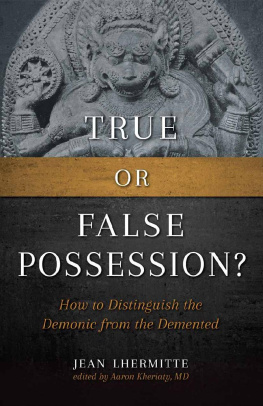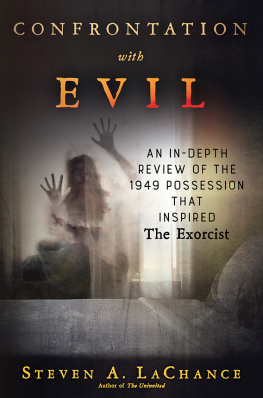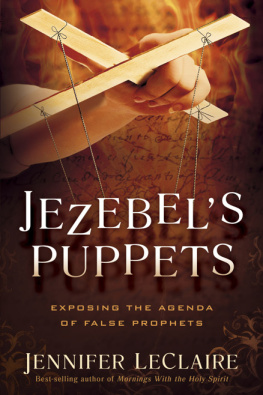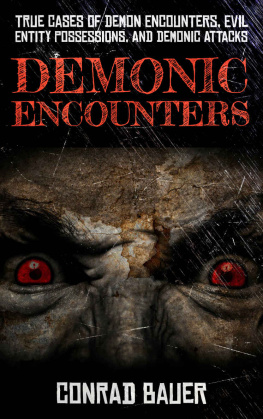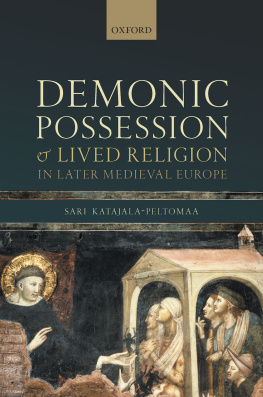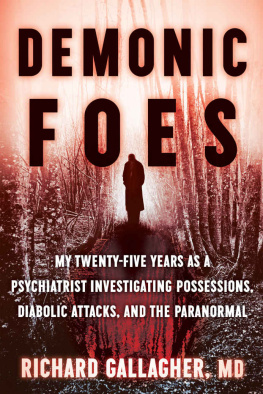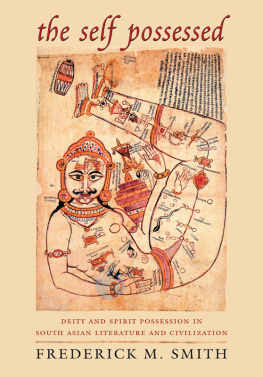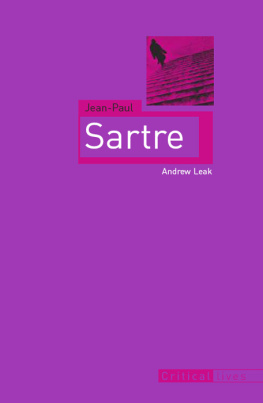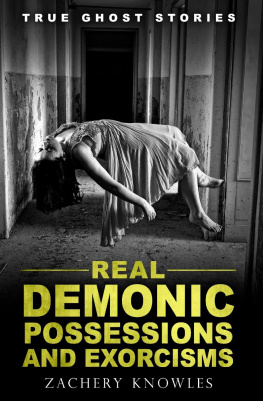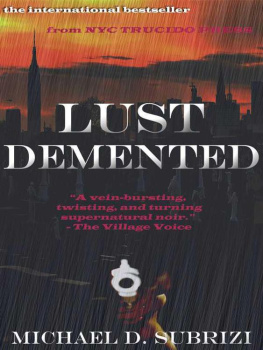Jean Lhermitte - True or False Possession: How to Distinguish the Demonic from the Demented
Here you can read online Jean Lhermitte - True or False Possession: How to Distinguish the Demonic from the Demented full text of the book (entire story) in english for free. Download pdf and epub, get meaning, cover and reviews about this ebook. year: 2013, publisher: Sophia Institute Press, genre: Religion. Description of the work, (preface) as well as reviews are available. Best literature library LitArk.com created for fans of good reading and offers a wide selection of genres:
Romance novel
Science fiction
Adventure
Detective
Science
History
Home and family
Prose
Art
Politics
Computer
Non-fiction
Religion
Business
Children
Humor
Choose a favorite category and find really read worthwhile books. Enjoy immersion in the world of imagination, feel the emotions of the characters or learn something new for yourself, make an fascinating discovery.
- Book:True or False Possession: How to Distinguish the Demonic from the Demented
- Author:
- Publisher:Sophia Institute Press
- Genre:
- Year:2013
- Rating:4 / 5
- Favourites:Add to favourites
- Your mark:
- 80
- 1
- 2
- 3
- 4
- 5
True or False Possession: How to Distinguish the Demonic from the Demented: summary, description and annotation
We offer to read an annotation, description, summary or preface (depends on what the author of the book "True or False Possession: How to Distinguish the Demonic from the Demented" wrote himself). If you haven't found the necessary information about the book — write in the comments, we will try to find it.
Jean Lhermitte: author's other books
Who wrote True or False Possession: How to Distinguish the Demonic from the Demented? Find out the surname, the name of the author of the book and a list of all author's works by series.
True or False Possession: How to Distinguish the Demonic from the Demented — read online for free the complete book (whole text) full work
Below is the text of the book, divided by pages. System saving the place of the last page read, allows you to conveniently read the book "True or False Possession: How to Distinguish the Demonic from the Demented" online for free, without having to search again every time where you left off. Put a bookmark, and you can go to the page where you finished reading at any time.
Font size:
Interval:
Bookmark:
Jean Lhermitte
True or False Possession?
How to Distinguish
the Demonic from the Demented
Edited by Aaron Kheriaty
SOPHIA INSTITUTE PRESS
Manchester, New Hampshire
True or False Possession? , an English translation by P. J. Hepburne-Scott of Vrais et faux possds (F. Brouty, J. Fayard, et Cie, 1956), was originally published in 1963 by Hawthorn Books, New York, as Volume 43 of the Twentieth Century Encyclopedia of Catholicism , edited by Henri Daniel-Rops. This 2013 edition by Sophia Institute Press includes minor editorial revisions and a new preface.
Copyright 2013 Sophia Institute Press
Printed in the United States of America
All rights reserved
Cover design by Ted Schluenderfritz
On the cover: Ancient Statue (159269408) Pavlo Lutsan / Photos.com; gray background (112384289) Attitude / Shutterstock.com.
No part of this book may be reproduced, stored in a retrieval system, or transmitted in any form, or by any means, electronic, mechanical, photocopying, or otherwise, without the prior written permission of the publisher, except by a reviewer, who may quote brief passages in a review.
Nihil obstat : Joannes M. T. Barton, S.T.D., L.S.S., Censor Deputatus
Imprimatur : E. Morrogh Bernard, Vicarius Generalis,
Westmonasterii, December 13, 1962
Sophia Institute Press
Box 5284, Manchester, NH 03108
1-800-888-9344
www.SophiaInstitute.com
Sophia Institute Press is a registered trademark of Sophia Institute.
Library of Congress Cataloging-in-Publication Data
Lhermitte, Jean, 1877-1959.
[Vrais et faux possedes. English]
True or false possession? : How to distinguish the demonic from the demented / Jean Lhermitte ; edited by Aaron Kheriaty.
pages cm
True and False Possession, an English translation by P. J. Hepburned Scott of Vrais et faux possedes (F. Brouty, J. Fayard, et Cie, 1956), was originally published in 1963 by Hawthorn Books, New York, as Volume 43 of the Twentieth Century Encyclopedia of Catholicism, edited by Henri Daniel-Rops.
Includes bibliographical references.
ISBN 978-1-933184-89-0 (pbk. : alk. paper)
eBook ISBN 978-1-622821-72-3 1. Demoniac possession.
I. Kheriaty, Aaron. II. Title.
BF1555.L553 2013
133.4'26 dc23
2013018313
Contents
Preface
by Aaron Kheriaty, MD
The question about the devil was put to me directly by a patient who had come to see me for treatment of depression and recovery from a serious drug addiction. As a physician, he had gained access to the intravenous anesthetic drug propofol and had self-administered it in order to escape from refractory insomnia and unrelenting depression. Without carefully titrated dosing, gleaned from his medical knowledge, this patient would surely have overdosed long ago. Indeed, it was something of a miracle that he was still alive.
During an interview, he suddenly interrupted the narrative of his psychiatric history, paused, and looked me directly in the eye. With a sober seriousness, and without a trace of hysterics or dramatization, he asked simply, Do you believe in the Devil?
I stared back. Yes. I do.
Me too, he said.
Then after a pause, I inquired: Why do you ask?
When I was injecting the propofol I felt something... enter into me. It was not the drug, but something else. The drug was just the gateway. It was... something... foreign.
At no point in his treatment did I suspect this patient to be possessed, in the strict sense of the term. Yet, neither did I doubt the reality of a malevolent influence on him that exceeded in power and scope the physiological effects of the anesthetic he was abusing. He later related to me how this evil spirit would mock and taunt him as he slipped deeper into the hell of drug addiction.
Most of my colleagues in psychiatry probably would have regarded this exchange between doctor and patient as rather puzzling, even ludicrous. They would likewise regard a book like the one you hold here as an oddity. A work purporting to distinguish between cases of true and false possession will seem to many a throwback to a bygone age of religious superstition. Yet a modern psychiatrist cannot help but be impressed by the authors perspicuous medical and psychological analysis of each case he examines in these pages. This is not the work of a premodern credulous dupe, but the work of a skilled and experienced neurologist, who knows his trade and sees his way clearly into the tangled workings of the human mind and heart.
The author, a physician and not a theologian, skillfully navigates the Scylla of credulity and the Charybdis of relentless skepticism. Inclined by training and clinical experience to search first for naturalistic medical or psychiatric explanations for the phenomena in question, he nevertheless leaves open the possibility of explanations that go beyond what science or medicine can assess, as well as the possibility that any given manifestation may have elements of both the natural and preternatural. Originally published over fifty years ago, the authors medical judgments and observations still hold true. While some clinical terminology may have changed in the interim, little could be brought to bear from modern neurology or psychiatry that would contradict his findings or conclusions. The clinical histories, fascinating in their own right aside from the authors clinical assessment, are presented with sober clarity and reserve.
Believers have sometimes made the mistake of finding supernatural possession where there was only a pathological personality, given to the grossest hysterics and deceptions. This book provides fascinating accounts of false-possession cases, for example, those of Marie-Thrse Noblet and Sr. Jeanne of the Angels. Here the author astutely notes that the repeated misapplication of the Rite of Exorcism may have exacerbated the behavioral disorder, in this case, hysterical (what we now call conversion) symptoms that were encouraged by the excessive attention received from the exorcist and by the public or overly dramatized way in which the exorcist misapplied the rite, in defiance of the prescriptions of the Roman Ritual. The curious onlookers fell prey to the colorful and dramatic, while the sick individual was motivated by receiving such attention. The author observes: Well known, too, were all the criteria which the Church holds to be decisive of genuine possession, but they were scarcely heeded in such cases. The cautionary note here comes not from a belief that the rite or the prayers themselves would be harmful, but rather from a desire to avoid an overly theatrical application of a sacramental in situations where the hysterical person was taking on the sick role precisely in order to draw attention to herself. The author discerns that it was the excessive attention, not the prayers of the rite itself, that could have exacerbated the behavioral symptoms.
In a similar vein, the author then recounts well-documented historical cases of mass hysteria and pseudoseizures, which often become contagious among those living in close quarters through suggestion and mimesis. Such phenomena could be accounted for by psychological observations known as early as the sixteenth century and given more definitive form in the work of the great French neurologist Charcot in the nineteenth century. Today, one could add a wider knowledge of culture-bound syndromes worldwide, with characteristically wild behavioral, dissociative, and somatic manifestations such as the clinical syndrome Amok found among the Malaysians. In such cases, as the author concludes, the influence of the demon is to be sought in vain. Yet he also notes correctly that hysteria is not playacting and that those who manifested this behavioral disorder were not consciously feigning their symptoms or deliberately trying to deceive: Hysterical patients, like all other sick people, deserve our understanding and our charity.
Next pageFont size:
Interval:
Bookmark:
Similar books «True or False Possession: How to Distinguish the Demonic from the Demented»
Look at similar books to True or False Possession: How to Distinguish the Demonic from the Demented. We have selected literature similar in name and meaning in the hope of providing readers with more options to find new, interesting, not yet read works.
Discussion, reviews of the book True or False Possession: How to Distinguish the Demonic from the Demented and just readers' own opinions. Leave your comments, write what you think about the work, its meaning or the main characters. Specify what exactly you liked and what you didn't like, and why you think so.

